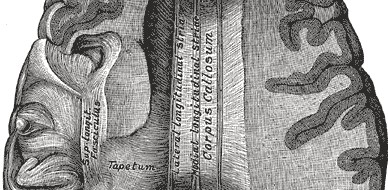Ryan McAdams is a Pediatrics professor and Neonatology Division Chief in the School of Medicine and Public Health’s Department of Pediatrics Division of Neonatology. A visual artist and writer, he has had several paintings, including Surf (Inaugural Issue), Dying Alone (Fall 2020), Disequilibrium (Fall 2021), The Rejected (Spring 2022), and Lucanian Dream (Fall 2023), and three poems My Land (Fall 2020), Letters of Absolution (Fall 2022), and Seat of Darkness (Spring 2024) published in Corpus Callosum.
Editor’s note: the terms art and artists are used as umbrella terms in this context and include both written and/or visual work.
Question 1: What drew you to writing and painting and what is your background in them?
McAdams: My entry into the realms of art and writing was shaped by the unexpected gifts life handed me. The first was quite literal—an old oil paint set from an aunt. Even though I was painting on paper, an unconventional canvas, this taught me some basics about texture and color. High school further broadened my palette, introducing me to a spectrum of artistic forms, from the translucence of stained glass to the immersive world of darkroom photography. Yet, my real artistic journey began in the basement of my mom’s home, a small corner room transformed into a studio where I built an easel with my younger brother and embarked on a journey of self-taught exploration. In medical school, I often pulled all-nighters painting and not studying. Now, as a neonatologist deeply committed to global health, I paint with a purpose: to champion causes that uplift mothers and children across the globe.
Parallel to my artistic endeavors, writing wove its way into my life, nurtured by influential educators and serendipitous encounters. My high school English teacher, Mary Kay Bissell, introduced me to the depths of Russian literature. College days brought the structured beauty of poetry into my grasp, including listening Allen Ginsberg recite “Howl,” a form I later revisited while in working in the Air Force as a neonatologist in Okinawa, Japan.
In Okinawa, my path crossed with a vivacious English teacher, the grandmother of a neonatal patient, who connected me with her friend, John O’Shea, a seasoned writer. My adaptation of “Howl,” titled “Whimper,” initiated our mentorship. John’s guidance was pivotal; he prescribed a reading list featuring authors like Norman MacLean and cautioned that mastering poetry would take years, a notion I initially resisted but came to respect deeply. This mentorship evolved into a rigorous daily writing practice, extending from poetry to nonfiction stories inspired by my medical missions. One such story, “Hearts in our Hands,” demanded years and over fifty revisions before its publication in the Examined Life Journal. John, ever the stern critic, also emerged as a cherished friend, pushing me to refine my craft and embrace the iterative nature of writing.
Question 2: What motivates you to create and what inspires your art?
McAdams: Nature and the human condition have always been inspirations for my art and writing. The natural world, in all its intricate beauty and grandeur, from the delicate dance of leaves in the wind to the ethereal glimmer of light on water, has been a constant source of inspiration. Similarly, the resilience and vulnerability of the newborns I care for in neonatology provide a profound perspective on life, infusing my creative work with a sense of wonder and a deep appreciation for the precious moments of existence.
Question 3: Do you have any favorite artists/writers or art/writings that have influenced you and who/what are they?
McAdams: My creative ethos has been shaped by a diverse array of artists and writers. The surreal landscapes of Salvador Dali, the intimate expressions of Georgia O’Keefe, and the vivid strokes of van Gogh have all left an indelible mark on my artistic vision. I like the simplicity and mystery of Edward Hopper and the colorful landscapes of Gustav Klimt. For more contemporary artists, I like Albert Oehlen and Yayoi Kusama.
As for writers, I like the poignant simplicity of Mary Oliver’s poetry and the raw, rich language of Seamus Heaney. For short stories, John Cheever’s are masterful.
Question 4: How do you balance your art with the rest of responsibilities in your life and does art help you in those other arenas of your life?
McAdams: The integration of art and writing into my life is less about balance and more about integration. My profession in neonatology, coupled with family commitments, occupies the forefront of my daily life. Art and writing find their place in the margins, in the stolen moments and the quiet hours of the night. This integration is not just a matter of time management but a reflection of how my experiences in medicine, family, and life at large seep into my creative expressions, enriching them with depth and authenticity.
Question 5: What is next for your art (anything you are working on now or planning to)?
McAdams: Looking ahead, I envision continuing my artistic and literary explorations, albeit in the interstices of professional and personal responsibilities. A dream project of mine is to create a platform, perhaps a museum or a collection, dedicated to art from orphans around the world. This endeavor would not only serve as a conduit for their voices but also to raise awareness and support for these children, marrying my passions for art, writing, and humanitarian work.
Question 6: Do you have any advice for anyone curious or interested in getting into art who hasn’t before?
McAdams: To those on the cusp of their own creative journeys, I say: leap into the process without fixation on the outcome. Both art and writing are not just about the end product but the journey there—the discoveries made, the emotions felt, and the personal growth that occurs along the way. Embrace exploration and expression, and let the joy of creating be your primary guide.
